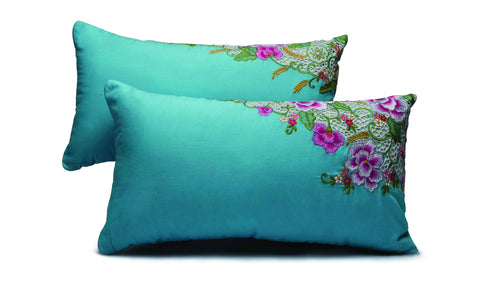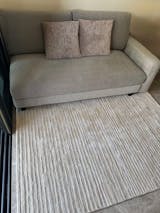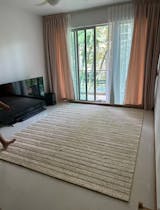Peranakan design captivates the hearts of many a culture vulture, and it is easy to understand why. Soft cheery pastels juxtapose in their dainty porcelain teapots and cups. If you've been to Malacca and Penang, chances are you fell in love with the multicoloured Peranakan shophouses. Instagram brims with 'shoe-fies' on patterned tiles in a dazzling range of designs and patterns. We in Singapore have a soft spot for Peranakan design, as it forms part of the Singaporean heritage.
'Shophouse' by Ingela Johansson, print available in store

'Emerald Hill' by Ingela Johansson, print available in store
When we found out about a line of handcrafted cushions by Peranakan designer Gwyneth Lim, the connection was instant. Gwyneth's designs capture the very elements that make a Peranakan culture so alluring. At the same time, it exudes the Australian vibe - bright, cheery and full of sunshine. "Lovingly made over some gossip". That's how Gwyneth describes her brand Ahnya Chi. She refers to the chatter among her female Peranakan elders as they stitch and embroider on leisurely days. Following tradition, I invite Gwyneth to D&A for an afternoon of 'gossip'. Here's what I found out.
Mixing and Matching Old with the New
Ahnya Chi is an eclectic range of textiles that draws inspiration from South East Asia and is stitched together through a sense of modern Australian design. Ahnya Chi draws from a six hundred-year-old heritage that began when early settlers went from China to the Malay Archipelago. They formed new identities and their children became known as
Peranakan, meaning
"locally-born".

Ahnya Chi Baba Patchwork Cushions
The Peranakans were well known for their impeccable and rather ostentatious taste in home decoration. Today, the modern interpretation seen in this range takes the essence of the Peranakans and makes it relatable to the discerning homeowner.
The home of Baba Chan Cheng Siew, a glimpse into the richness of the culture and the opulence that was fashionable in many pre-World War II Peranakan homes
Get to Know the Peranakan Culture
Chinese migrants arrived in the Straits of Malacca and made their home in what is now Malacca, Penang and Singapore. They intermarried with the local ladies of Bugis, Batak, Javanese, and Thai tribes. They started mixing the local Malay language into their Hokkien mother tongue.
The men played lawn bowling, owned rubber estates and thoroughly enjoyed the anglophile lifestyles of the British Empire. The women wore
sarongs, ate
sambal belacan and had rather high expectations of their daughters-in-law. They were known for impeccable taste in fashion, styling and the latest in home decoration.

Baba & Nyonya Heritage Museum in Malacca
Baba & Nyonya Heritage Museum's book tour is a delightful introduction to the Peranakan culture.
Download it here.
The Cushion Collection (and Peranakan Terminology You Should Know)
Learning about the Ahnya Chi Cushion collection is fun. You learn Peranakan terms along the way. Here are some important vocabulary every design lover in Asia should be equipped with.
1. Nyonya
/ˈnɒnyə/ n. simply means 'lady'
Malay, Javanese word probably from Portuguese senhora 'lady'.
Nyonya Ensemble by Penang artist Yuen Chi Ling, oil on canvas 2005
2. Ahnya
/ɑːnyə/ n. short form of Ahhhh-Nya, in turn a short form of Nyonya. It is a term of endearment for a young Nyonya. It is the term Gwyneth was lovingly referred to by her nearest and dearest. Hence her brand name Ahnya Chi.
3. Kebaya
/kəˈbɑːyə/ n. a light, loose tunic worn by a Nyonya, usually decorated with embroidery especially near the hips.
Young Nyonyas - Designer Gwyneth Lim in the middle - wearing kebayas
Ahnya-Chi’s first collection of Kebaya Chi cushions used beautiful kebayas plucked from their own family’s collection. These were all one-off pieces, where the elaborate embroidered bottom tips of the kebaya were cut and sewn to create a set of two cushions.

Kebaya Baby-Chi Peranakan Cushion
“My mother is Peranakan and kebayas are part of her heritage. I appreciate the craftsmanship and the intricate details of kebaya. At the beginning, I couldn’t tell the difference but now, I can tell whether a kebaya is good quality,” says Gwyneth.

Kebaya Ah Beat-Chi Peranakan Cushion
The Kebaya Straits Collection is made with artisans who handcraft traditional kebayas. The way in which the embroidery has been placed keeps the integrity of how the kebayas are made, thereby forming a pair of accented cushions.
Kebaya Winnie-Chi Peranakan Cushion
4. Baba
ˈ/bɑːbɑː/ n. an honorific term for a Peranakan man

Babas, from The Peranakan Museum archives
Peranakan inspired designs often use feminine pastels similar to their porcelain work. Gwyneth designs a cushion that begs to differ. She prides in the Baba Collection, personifying the Peranakan gentleman. "Baba features a more modern and neutral design, which are ideal for homes without any Asian influences."
Baba comes in neutral colours but with a subtle flair of batik patchwork. These cushions are designed in four versatile configurations.

Baba Cushions in Snow, Sand and Olive
About the Designer
A graduate in communication design, Gwyneth Lim was born in Malaysia. She worked in Kuala Lumpur for fifteen years before becoming a resident in Australia. During her transition of assimilating into Perth, she began to have a new appreciation for her Asian roots. The process of designing has allowed her to introduce what she values of her culture, and its aesthetics to Australia. It is through this process that Ahnya Chi was born.
References:
1. Oxford Dictionary www.oxforddictionaries.com
2. Knapp, Ronald. The Peranakan Chinese Home: Art and Culture in Daily Life
3. The Peranakan Museum in Singapore, Asian Civilizations Museum | 39 Armenian Street, Singapore 179941
4. Baba Nyonya Heritage Museum, Malacca | No. 48 & 50 Jalan Tun Tan Cheng Lock, 75200 Melaka, Malaysia
5. Penang Art www.penang-art.com



















